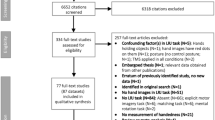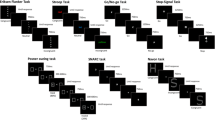Abstract
We assessed the relationship between grip preference and hand use in chimpanzees in 2 experiments. In experiment 1, we evaluated consistency in hand use and grip preference across 4 food types. The chimpanzees showed population-level right-handedness and there are significant positive associations for both hand and grip use across food types. In experiment 2, we assessed validity of hand use in relation to grip preference in 2 colonies of chimpanzees via the same methodology. Differences in hand preferences between colonies were associated with variation in the observed grip preferences. There was no evidence of rearing effects on handedness in either colony. We discuss the overall results in the context of the evolution of handedness in relation to increasing motor demands as manifest in variation on grasping behavior.
Similar content being viewed by others
References
Boesch, C., and Bosech, H. (1993). Different hand postures for pounding nuts with natural hammers by wild chimpanzees. In Preuschoft, H., and Chivers, D. J. (eds.), Hands of primates, Springer-Verlag, New York, pp. 31–43.
Bradshaw, J., and Rogers, L. J. (1993). The Evolution of Lateral Asymmetries, Language, Tool Use and Intellect. San Diego: Academic Press.
Byrne, R. W., Corp, N., and Byrne, J. M. (2001). Manual dexterity in the gorilla: Bimanual and digit role differentiation in a natural task. Anim. Cognit. 4: 347–361.
Corballis, M. C. (1992). The Lopsided Brain: Evolution of the Generative Mind, Oxford University Press, New York.
Christel, M. I. (1994). Catarrhine primates grasping small objects: Techniques and hand preferences. In Anderson, J. R., Roeder, J. J., Thierry, B., and Herrenschmidt, N. (eds.), Current Primatology vol IV: Behavioral Neuroscience, Physiology and Reproduction, Universite Louis Pasteur, Strasbourg, pp. 37–49.
Christel, M. I., Kitzel, S., and Niemitz, C. (1998). How Precisely do bonobos (Pan Paniscus) grasp small objects? Int. J. Primatol. 19: 165–194.
Ehrsson, H. H., Fagergren, A., Jonsson, T., Westling, G., Johansson, R. S., and Forssbery, H. (2000). Cortical activity in precision-versus power-grip tasks: An fMRI study. J. Neurophysiol. 83: 528–536.
Ettlinger, G. (1988). Hand preference, ability, and hemispheric specialization: How far are these factors related in the monkey ? Cortex 24: 389–398.
Fagot, J., and Vauclair, J. (1991). Manual laterality in nonhuman primates: A distinction between handedness and manual specialization. Psycholo. Bull. 109: 76–89.
Hook-Costigan, M. A., and Rogers, L. J. (1997). Hand preferences in New World primates. Int. J. Com. Psychol. 9: 173–207.
Hopkins, W. D. (1993). Posture and reaching in chimpanzees (Pan) and orangutans (Pongo). J. Com. Psychol. 17: 162–168.
Hopkins, W. D. (1999). On the other hand: Statistical issues in the assessment and interpretation of hand preference data in nonhuman primates. Int. J. Primatol. 20: 851–866.
Hopkins, W. D., and Dahl, J. F. (2000). Birth order and hand preference in chimpanzees (Pan troglodytes): Implications for pathological models of human handedness. J. Comp. Psychol. 114: 302–306.
Hopkins, W. D., and Russell, J. L. (2004). Further evidence of a right hand advantage in motor skill by chimpanzees (Pan troglodytes). Neuropsychologia 42: 990–996.
Hopkins, W. D., Dahl, J. F., and Pilcher, D. (2000). Birth order and left-handedness revisited: Some recent findings in chimpanzees (Pan troglodytes) and their implications for developmental and evolutionary models of human handedness. Neuropsychologia 38: 1626–1633.
Hopkins, W. D., Bennett, A., Bales, S., Lee, J., and Ward, J. P. (1993). Behavioral laterality in captive bonobos (Pan paniscus). J. Comp. Psychol. 107: 403–410.
Hopkins, W. D., and Cantalupo, C. (in press). Does variation in sample size explain individual differences in hand preferences of chimpanzees (Pan troglodytes)? An empirical study and reply to Palmer (2002). Am. J. Phys. Anthropol.
Hopkins, W. D., Cantalupo, C., Wesley, M. J., Hostetter, A., and Pilcher, D. (2002). Grip morphology and hand use in chimpanzees (Pan troglodytes): Evidence of left hemisphere specialization in motor skill. J. Experim. Psychol. Gen. 131: 412–423.
Jones-Engel, L. E., and Bard, K. A. (1996). Precision grips in young chimpanzees. Am. J. Primatol. 39: 1–15.
Lehman, R. A. W. (1993). Manual preference in prosimians, monkeys, and apes. In Ward, J. P., and Hopkins, W. D. (eds.), Primate Laterality: Current Behavioral Evidence of Primate Asymmetries, Springer-Verlag, New York, pp. 107–124.
MacNeilage, P. F., Studdert-Kennedy, M. G., and Lindblom, B (1987). Primate handedness reconsidered. Behav. Brain Sci. 10: 247–303.
Marchant, L. F., and McGrew, W. C. (1991). Laterality of function in apes: A meta-analysis of methods. J. Hum. Evol. 21: 425–438.
Marzke, M. W. (1997). Precision grips, hand morphology and tools. Am. J. Phys. Anthropol. 102: 91–110.
McGrew, W. C., and Marchant, L. F. (1997). On the other hand: Current issues in and meta-analysis of the behavioral laterality of hand function in nonhuman primates. Yearbook Phys. Anthropol. 40: 201–232.
Olson, D. A., Ellis, J. E., and Nadler, R. D. (1990). Hand preferences in captive gorillas, orangu-tans, and gibbons. Am. J. Primatol. 20: 83–94.
Palmer, A. R. (2002). Chimpanzee right-handedness reconsidered: Evaluating the evidence with funnel plots. Am. J. Phys. Anthropol. 118: 191–199.
Searleman, A., Porac, C., and Coren, S. (1989). Relationship between birth order, birth stress, and lateral preferences: A critical review. Psychol. Bull. 105: 397–408.
Tonooka, R., and Matsuzawa, T. (1995). Hand preferences in captive chimpanzees (Pan troglodytes) in simple reaching for food. Int. J. Primatol. 16: 17–34.
De Vleeschouwer, K., Van Elsacker, L., and Verheyen, R. F. (1995). Effect of posture on hand preferences during experimental food reaching in bonobos (Pan paniscus). J. Comp. Psychol. 109: 203–207.
Ward, J. P., Milliken, G. W., and Stafford, D. L. (1993). Patterns of lateralized behavior in prosimians. In Ward, J. P., and Hopkins, W. D. (eds.), Primate Laterality: Current Behavioral Evidence of Primate Asymmetries, Springer-Verlag, New York, pp. 43–76.
Warren, J. M. (1980). Handedness and laterality in humans and other animals. Physiol. Psychol. 8: 351–359.
Westergaard, G. C., Kuhn, H. E., and Suomi, S. J. (1998). Bipedal posture and hand preference in humans and other primates. J. Comp. Psychol. 112: 56–63.
Author information
Authors and Affiliations
Corresponding author
Rights and permissions
About this article
Cite this article
Hopkins, W.D., Russell, J.L., Hook, M. et al. Simple Reaching Is Not So Simple: Association Between Hand Use and Grip Preferences in Captive Chimpanzees. Int J Primatol 26, 259–277 (2005). https://doi.org/10.1007/s10764-005-2924-y
Received:
Accepted:
Issue Date:
DOI: https://doi.org/10.1007/s10764-005-2924-y




